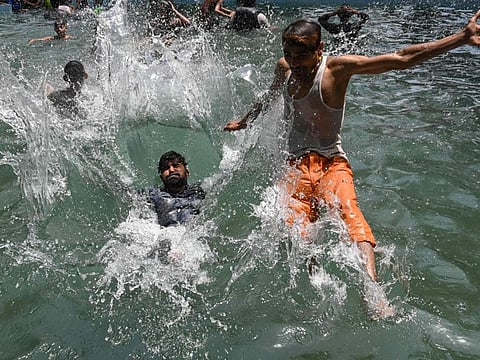Pakistan grapples with intense heat wave and long power outages
Mercury is expected to touch 50°C this week as the heat wave to persist until June 24

Islamabad: Pakistanis are grappling with the dual challenge of a blistering heat wave in most parts of the country and frequent power outages.
Islamabad administration urged PIMS and Polyclinics hospitals to prepare for medical emergencies during the hot weather. In Islamabad, the mercury reached 42 degrees Celsius during the day on Thursday, but the feels-like temperature was about 47°C.
With temperatures across Pakistan soaring above 42 degrees Celsius this week and expected to reach the 50-degree mark, local authorities have issued advisories urging the public to take precautions against the scorching heat wave. The National Disaster Management Authority (NDMA) recommended increasing the use of water, avoiding carbonated drinks, and minimizing outdoor activities during the peak hours of the day.
“Cover your head before going out in the hot sun. Take special care of the sick, elderly, children, and pets. Drink lemon water and ORS to compensate for the salt deficiency. Wear light and soft clothes,” it advises. In case of fainting due to heat, pouring cold water on the head is suggested.
Power cuts
On Thursday, a number of residents in Islamabad city reported more than six hours of load shedding and low voltage throughout the night, exacerbating the already challenging conditions caused by the relentless heatwave.
Pakistani media reported that citizens in urban areas are enduring six to eight hours of power cuts, while rural regions are facing 10-12 hours of load shedding during this week of extreme heat.
“It feels like there is no respite from the scorching heat as the power outages have made lives absolutely unbearable. This is a serious health risk, particularly for the elderly and children in the family,” complained Rafia Ahmed, a resident of Rawalpindi and housewife.
Businesses, shops, and factories claimed that they are facing losses due to the prolonged power cuts. Pakistan’s current peak summertime electricity demand is approximately 27,000MW, and the country is facing a shortfall of about 7,000 MW, leading to power cuts, according to local media.
The Pakistan Met Office had earlier warned that most parts of Pakistan would experience “heat wave-like conditions” and rising temperatures until June 24. The Pakistan Meteorological Department (PMD) said that the day temperatures in Islamabad, upper and central Punjab, upper Khyber Pakhtunkhwa, and Gilgit-Baltistan are expected to endure 4 to 6 degrees Celsius above normal.
Similarly, Sindh, South Punjab, and Balochistan may experience 2 to 4 degrees Celsius above normal temperatures. There is a chance of rain with dusty winds and thunderstorms on June 23 in parts of Balochistan and Kashmir.
Highest temperatures recorded
Over the past 24 hours, the weather has been exceptionally hot and humid throughout the South Asian country. The maximum temperatures reached 49 degrees Celsius in Nokundi (Balochistan), 46°C in Sibbi (Balochistan) and Dadu (Sindh), 44°C in Sargodha (Punjab), 43°C in Dera Ismail Khan (Khyber Pakhtunkhwa), and an astonishing 42°C in the mountainous city of Gilgit.
Flood and GLOF warning
The Met Office has cautioned that above-normal temperatures this week, followed by a rain system, could increase river inflows, which may trigger flash floods and glacial lake outburst floods (GLOF) in the vulnerable glacier areas of Gilgit-Baltistan (GB) and some parts of Khyber Pakhtunkhwa (KP).
The district administration, local organizations, and communities have been asked to “remain vigilant and take precautionary measures” due to expected extreme weather events, especially during the Eid Al Adha week. Last year, more than 30 GLOF incidents were reported across GB, leaving 20 people dead and destroying dozens of homes.
Sign up for the Daily Briefing
Get the latest news and updates straight to your inbox



